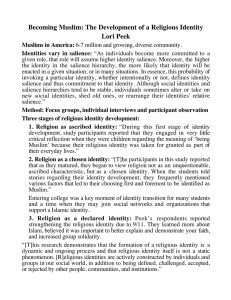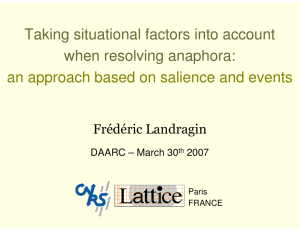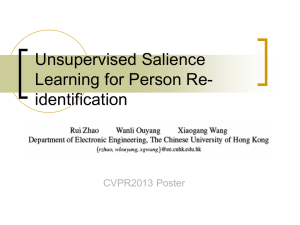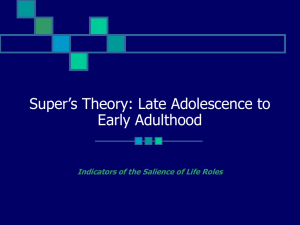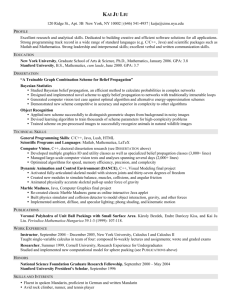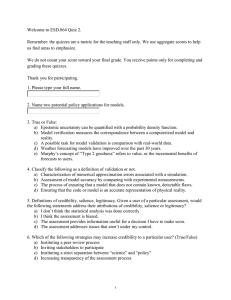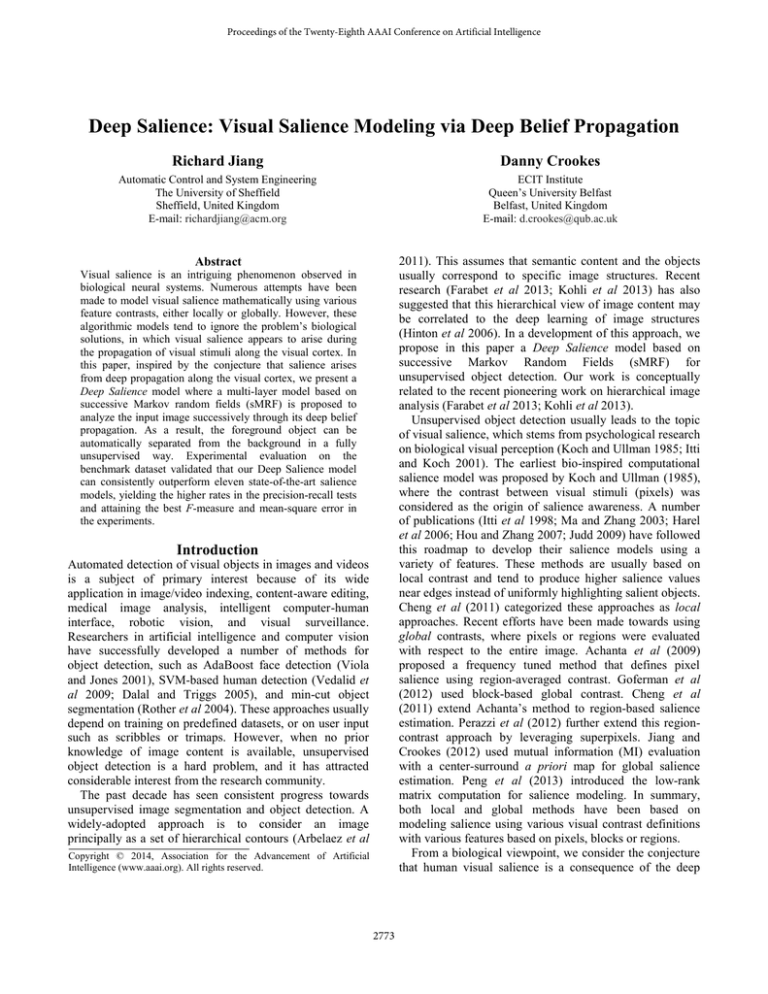
Proceedings of the Twenty-Eighth AAAI Conference on Artificial Intelligence
Deep Salience: Visual Salience Modeling via Deep Belief Propagation
Richard Jiang
Danny Crookes
Automatic Control and System Engineering
The University of Sheffield
Sheffield, United Kingdom
E-mail: richardjiang@acm.org
ECIT Institute
Queen’s University Belfast
Belfast, United Kingdom
E-mail: d.crookes@qub.ac.uk
Abstract
2011). This assumes that semantic content and the objects
usually correspond to specific image structures. Recent
research (Farabet et al 2013; Kohli et al 2013) has also
suggested that this hierarchical view of image content may
be correlated to the deep learning of image structures
(Hinton et al 2006). In a development of this approach, we
propose in this paper a Deep Salience model based on
successive Markov Random Fields (sMRF) for
unsupervised object detection. Our work is conceptually
related to the recent pioneering work on hierarchical image
analysis (Farabet et al 2013; Kohli et al 2013).
Unsupervised object detection usually leads to the topic
of visual salience, which stems from psychological research
on biological visual perception (Koch and Ullman 1985; Itti
and Koch 2001). The earliest bio-inspired computational
salience model was proposed by Koch and Ullman (1985),
where the contrast between visual stimuli (pixels) was
considered as the origin of salience awareness. A number
of publications (Itti et al 1998; Ma and Zhang 2003; Harel
et al 2006; Hou and Zhang 2007; Judd 2009) have followed
this roadmap to develop their salience models using a
variety of features. These methods are usually based on
local contrast and tend to produce higher salience values
near edges instead of uniformly highlighting salient objects.
Cheng et al (2011) categorized these approaches as local
approaches. Recent efforts have been made towards using
global contrasts, where pixels or regions were evaluated
with respect to the entire image. Achanta et al (2009)
proposed a frequency tuned method that defines pixel
salience using region-averaged contrast. Goferman et al
(2012) used block-based global contrast. Cheng et al
(2011) extend Achanta’s method to region-based salience
estimation. Perazzi et al (2012) further extend this regioncontrast approach by leveraging superpixels. Jiang and
Crookes (2012) used mutual information (MI) evaluation
with a center-surround a priori map for global salience
estimation. Peng et al (2013) introduced the low-rank
matrix computation for salience modeling. In summary,
both local and global methods have been based on
modeling salience using various visual contrast definitions
with various features based on pixels, blocks or regions.
From a biological viewpoint, we consider the conjecture
that human visual salience is a consequence of the deep
Visual salience is an intriguing phenomenon observed in
biological neural systems. Numerous attempts have been
made to model visual salience mathematically using various
feature contrasts, either locally or globally. However, these
algorithmic models tend to ignore the problem’s biological
solutions, in which visual salience appears to arise during
the propagation of visual stimuli along the visual cortex. In
this paper, inspired by the conjecture that salience arises
from deep propagation along the visual cortex, we present a
Deep Salience model where a multi-layer model based on
successive Markov random fields (sMRF) is proposed to
analyze the input image successively through its deep belief
propagation. As a result, the foreground object can be
automatically separated from the background in a fully
unsupervised way. Experimental evaluation on the
benchmark dataset validated that our Deep Salience model
can consistently outperform eleven state-of-the-art salience
models, yielding the higher rates in the precision-recall tests
and attaining the best F-measure and mean-square error in
the experiments.
Introduction
Automated detection of visual objects in images and videos
is a subject of primary interest because of its wide
application in image/video indexing, content-aware editing,
medical image analysis, intelligent computer-human
interface, robotic vision, and visual surveillance.
Researchers in artificial intelligence and computer vision
have successfully developed a number of methods for
object detection, such as AdaBoost face detection (Viola
and Jones 2001), SVM-based human detection (Vedalid et
al 2009; Dalal and Triggs 2005), and min-cut object
segmentation (Rother et al 2004). These approaches usually
depend on training on predefined datasets, or on user input
such as scribbles or trimaps. However, when no prior
knowledge of image content is available, unsupervised
object detection is a hard problem, and it has attracted
considerable interest from the research community.
The past decade has seen consistent progress towards
unsupervised image segmentation and object detection. A
widely-adopted approach is to consider an image
principally as a set of hierarchical contours (Arbelaez et al
Copyright © 2014, Association for the Advancement of Artificial
Intelligence (www.aaai.org). All rights reserved.
2773
propagation of visual stimuli along the human visual cortex
(Ekstorm et al 2008). Hence, it is a complex procedure
rather than a simple visual comparison using color contrast.
To emulate this biological process, we present a Deep
Salience model using our proposed successive Markov
Random Fields (sMRF) model.
In our sMRF model, a fuzzy graph is introduced with a
Markov Random Field to allow each node to maximize its
belief by solving the fuzziness of edges. When applied to a
cascaded multi-scale image pyramid, the pyramid structure
of multiple-layer MRFs forms successive MRFs (sMRFs)
which processes the input visual signals via its deep belief
propagation along layers, while a belief maximization
procedure is applied to detect salient objects automatically
from its iterative convergence. Fig.1 shows an example of
applying our Deep Salience method to a challenging image.
a) An image
b) Our DS result
c) Ground truth
d) Salience maps from several state-of-the-art methods
Fig.1. A simple example that challenges most state-of-theart methods. a) The image; b) Our Deep Salience(DS)
map; c) Ground truth; d) Results by several state-of-the-art
salience methods, SR (Hou & Zhang 2007), IT (Itti et al in
1998), GB (Harel et al 2006), MZ (Ma & Zhang 2003), LC
(Zhai & Shah 2006), FT (Achanta et al 2009), CA
(Goferman et al 2010), and RC (Cheng et al 2011). Here
the ‘jet’ color map is applied to visualize the results.
Successive Image Analysis
In image structure analysis, hierarchical analysis has been
effective in tackling various computer vision tasks. Lowe
(2004) proposed the use of a pyramid computation of DoG
for multi-scale feature point detection. Sun and Pfister
(2013) applied a pyramid-based coarse-to-fine approach to
optical flow and achieved improved accuracy. In these
methods, images were processed at different scales and the
computation was carried out hierarchically. In the recent
research (Arbelaez et al 2011; Farabet et al 2013; Kohli et
al 2013), images have been considered as a collection of
hierarchical contours. While hierarchical methods have
been seen very successful in these challenging vision tasks,
in this paper we apply this strategy to our visual salience
analysis for unsupervised object detection.
In our method, the first step is to compute a pyramid of
hierarchical images. Usually this can be done by using
discrete wavelet transform (DWT). Given an input image,
the 2D DWT computation will result in four components,
namely LL, LH, HL and HH, as shown in Fig.2-a. In our
approach, we keep only the LL (low-pass) component of
each level. Consequently, we obtain a hierarchical pyramid
of resized images at different resolutions, as shown in
Fig.2-b. Our Deep Salience method will then take these
images as input, and perform hierarchical analysis
successively from the top of the pyramid downwards. The
proposed coarse-to-fine process is akin to an emulation of
the human visual system where the input visual signals are
propagated along the visual cortex from eyes to brain
(Koch and Ullman 1985; Ekstorm et al 2008).
a) Successive DWT
b) Hierarchical pyramid
Fig.2. Hierarchical image analysis with wavelet pyramid.
Fig.3 The proposed successive Markov random fields allow
multi-layer deep belief propagation downwards along
directed edges.
with respect to G when they satisfy the local Markov
properties that a variable is conditionally independent of
any variables that are not its neighbors. Hence, global
belief propagation over a CRF can then be simplified as
local belief propagation over cliques.
Our work starts from the pair-wise MRF model proposed
by Jegelka and Bilmes (2011). Let V be the set of pixels in
the image X we want to process, and let the set E contain all
pairs of neighboring pixels that are edges in the MRF. The
Maximum Belief Propagation in MRF
Markov random fields have been a powerful tool for image
analysis. Given an undirected graph G = (V, E) and
observations X={xk} with k∈V indexed by V, a set of
random variables Y={yk} forms a conditional random field
2774
denotes the conservative probability from the jth vertex
to the ith vertex, which can be simply formulated with the
feature difference between the ith and jth pixels:
(2)
xi x j
ij
ij
a) Sample image
b) Level 4
Here, ψ(·) denotes a penalty function when the belief is
propagated across two color-different pixels. For example,
given a pixel k0 with a confidence P0, a neighbor k1 with
exactly the same color should have a confidence P1=P0
with ij=0.
A node in a MRF may have multiple edges. Typical
MRF methods using mean field continuum approximation
(Yedidia et al 2005) may easily bleach the edges in an
image and allow the belief propagation to cross region
borders. To address this problem, we introduce a maximum
belief propagation algorithm. We consider all edges of a
node as a potential fuzzy edge in a fuzzy graph (Kosko
1986; Blue and Bush 2002; Salzenstein and Collet 2006)
~
~
G V , E . Hence, the pixel may have multiple choices of
likelihood Pij inferred from different edges, and the
fuzziness can be described by:
Fi
f ij Pi j
f ij Pj ij
(3)
c) Level 3
d) Level 2
e) Level 1
f) Level 0
Fig.4. Deep Salience: Successive salience analysis via
deep belief propagation over sMRF.
j C
j C
Here, fij stands for the fuzziness of the j-th fuzzy edge. To
maximize the belief in propagation, we apply a winnertakes-all strategy in the local iteration over random fields,
1, when j arg max Pi j
(4)
j
f ij
0, otherwise
In the above winner-takes-all strategy, a node always
favors the edge with the maximum confidence and
dynamically sets other fuzzy edges as disconnected.
A major advantage of the above maximum belief
propagation (MBP) algorithm is to guarantee that belief
propagation in MRF will not blur the region borders in an
input image. Besides, by disconnecting some edges
dynamically, MBP inference problem is simplified into a
local search of the winner in the fuzzy set of neighbors. In
an analogy, the above MBP is more like a quantum
mechanism (Birkhoff and Neumann 1936) that allows each
node to switch between multiple quantum energy levels,
while each fuzzy edge stands for a specific quantum energy
level. For our convenience, we refer to our above simple
implementation of MBP random fields as Quantum
Random Fields (QRF) in this paper. Fig.5 shows the
different belief propagation results in our Deep Salience
model using typical MRF and our QRF. It is shown that
QRF can easily converge on the salient object quickly.
Images
QRF (0.1sec)
MRF (3.5sec)
Fig.5. DS modeling with sMRF using our QRF or
standard MRF at each layer. QRF-based DS takes only
0.1s and highlights the foreground object, while typical
MRF based DS needs longer time (3.5s) and blurs the
region borders.
Images
One-layer MRF
sMRF
Fig.6. sMRF vs one-layer MRF: sMRF helps overcome
the texture problem by its deep belief propagation.
label of each pixel in V is given by a binary random
variable yi whose labels (0/1) denote the label
“foreground”/“background”.
Considering a clique of two vertices i and j, if the
confidence on the i-th vertex is known as Pi, the belief
propagation along the clique edge can be inferred as a MAP
(maximum a posteriori) formula:
(1)
Pi Pj ij
Deep Belief Propagation via Successive MRF
Successive Markov Random Field
In research in unsupervised image segmentation and object
detection, a common approach is to consider an image as a
set of hierarchical contours (Arbelaez et al 2011). Recent
2775
propagated based on the coarse observation from the top
level, and successively downward to the lower sMRF
layers. It can be seen that the resolution of the confidence
maps increases and the details are gradually added via deep
belief propagation. In our experiment, we use SF method
(Perazzi et al 2012) to initialize the border and keep nonsalient pixels as initial background.
The benefits of sMRF over single-layer MRF stem from
its successive analysis of hierarchical image structures. It
focuses on global structures at its initial coarse level and
gradually focuses on local details in the subsequent levels.
Therefore, it can allow belief propagation to go across
texture regions easily. Fig.6 shows several examples
comparing sMRF against single-layer MRF. We can see
that the belief propagation in single-layer MRF gets stuck
in texture-like regions in the background, while sMRF can
overcome these local textures and highlight the salient
foreground objects successfully in these test images.
Fig.7. Computing time versus the number of pixels N.
Table I. Convergence time vs the number of layers (ms)
Layers 1 Layer
1st
210
2nd
-3rd
-4th
-5th
-Total
210
2 Layer
103
29
---132
3 Layer
78
16
6
--100
4 Layer
61
14
3
2
-80
5 Layer
12
4
3
2
2
23
Computing Complexity
Usually, the computing complexity of MRF is not readily
predictable. However in our sQRF, the problem can
become much easier. While the belief propagation is
simplified as a local maximum problem in Eq.(5), the
computing time is proportional to the range for a belief to
propagate from the source to the pixel, which is related to
the number of pixels. As shown in Fig.7, our experiment
validated that the convergence time of sQRF is nearly
proportional to the number of pixels, namely O(N).
It is noted that sMRF needs to converge on multiple
layers. However, the number of nodes has been reduced to
1/2k, and the search space at the top level of the pyramid is
then drastically reduced to (1/2k)2 as well. While the sMRF
iteration moves downwards, the pre-converged confidence
map is inherited by the next level and hence it can be
expected to help reduce the total convergence time. Table I
gives the experimental results of the computation times at
different layers. The computing time was measured for a
MATLAB solution. We can see that the single-level MRF
took the longest time to converge (210 ms), while 5-level
sMRF needs only 23 ms in total for all five levels. From
this comparison we can see that successive MRF not only
helps overcome texture background, but also helps reduce
the computing time.
research (Farabet et al 2013; Kohli et al 2013) has also
suggested that this hierarchical view of image content may
be correlated to the deep learning of image structures.
As mentioned above, a pyramid of hierarchical images
can be obtained from an input image using DWT, as shown
in Fig.2. Each image in the pyramid can be mapped as an
observation for each layer of successive MRF (sMRF).
Fig.3 shows the concept of sMRF, where fuzzy edges not
only present in one layer of random fields, but also connect
a layer to the previous and next layers. Hence, the belief
propagation is carried out down the pyramid of random
fields. For a node in our successive QRF (sQRF), its interlayer edges can be added into the search of its maximum
belief,
(5)
jm arg max{Pi j , Pi }
j,
Here Pi is the estimated belief propagated from the nodes
in other layers. In this work, we assume that the inter-layer
connection is unidirectional so that the belief can only
propagate from the upper layer to its lower layer. This
implies an inheritance of the confidence map hierarchically
down the pyramid from coarse to fine.
Starting from the top level of sMRF, we carry out the
maximum belief propagation process (in Eq.(5)) iteratively
over each layer of our quantum random field to solve its
fuzziness. The computation on the top image (the one
resized to 1/2k) gives the result as the kth level belief map
Gk. Then the belief map is propagated to the next layer
down the pyramid.
Fig.4 shows an example of sMRF. Fig.4-a shows the
sample image where, similar to Judd’s work (2009), we
assume that most pixels on the borders are taken as
background (PB=1). With this priori, the belief is then
Experiments
We tested our method on the widely used object dataset --the EPFL object dataset (Achanta et al 2009), which is
publicly available and the ground truth of foreground
objects is provided as binary masks. Most state-of-the-art
methods have been reported with their benchmark results
on this dataset. The EPFL dataset has the same images as
MSRA-1000 except that it takes segmented objects as
ground truth instead of gaze points from psychological
2776
Fig.8. Visual comparison of salience maps. From left to right columns: original images; ground truth; salience maps from
1) SR; 2) IT; 3) GB; 4) MZ; 5) LC; 6) FT; 7) CA; 8) HC; 9) RC; 10) SF; and our Deep Salience (DS) maps. It can be seen
that our DS model can robustly highlight salient objects in images where other algorithms failed.
et al 2009), CA (Goferman et al 2010), HC and RC (Cheng
et al 2011), MI (Jiang & Crookes 2012) and SF (Perazzi et
al 2012). The following are our experimental results.
Visual Comparison
Fig.8 provides a visual comparison of the various methods
using a number of sample images. Most of the state-of-theart methods failed to find the salient objects in these test
images. In comparison, we can see that our Deep Salience
method using sMRF can robustly highlight salient objects
from their background.
Fig.9 shows several more examples. By applying
thresholds of 2*mean and 3*mean respectively to the
salience maps, we have firstly identified object-like regions
(shown as red rectangles) and then, even further, attempted
to identify their salient parts (shown as green rectangles).
The success of our sQRF-based object detection can be
attributed to the use of hierarchical analysis that is able to
capture the global spatial structures of an image. However,
we note that we did not build any contrast-based salience
model explicitly. Instead, object detection is a natural
outcome of maximizing the belief iteratively over the sQRF.
Statistic Evaluation
a) Input images
b) DS maps c) Detected objects
Fig.9. Unsupervised object detection with our Deep
Salience model. Red rectangles denote the object-like
regions, and green ones highlight the most salient parts.
Fig.10-a shows the typical statistical results of precisionrecall curves for the EPFL dataset. The curves are
computed in the same way as reported by previous work.
Here, precision corresponds to the percentage of salient
pixels correctly assigned, while recall rate corresponds to
the fraction of detected salient pixels in relation to the
number of ground truth salient pixels. As shown in Fig.10-a,
our method achieves the best overall precision and recall
rates of all the compared methods, and consistently
outperforms previous salience models in term of precision
and recall rates. It is also observed that the DS curve goes
up much steeper than other methods.
measurement. Hence, the dataset is well suited to our
purpose of unsupervised object detection.
Our algorithm was implemented in MATLAB. We ran
our code on the dataset, and compared the results against
11 state-of-the-art unsupervised visual salience models.
The methods for comparison include: SR (Hou & Zhang
2007), IT (Itti et al in 1998), GB (Harel et al 2006), MZ
(Ma & Zhang 2003), LC (Zhai & Shah 2006), FT (Achanta
2777
can get the precision and recall of its binary cut, and then
the F-measure can be subsequently computed by:
Precision Recall
(6)
F
Recall Precision
From Fig.10-b, we can see that our Deep Salience achieves
the best F-measure score than all the other methods in the
comparison.
Precision and recall measures do not consider true
negative salience assignment, i.e., the number of pixel
correctly marked as non-salient. Moreover, the quality of
the weighted, continuous saliency maps may be of higher
importance than the binary masks from psychological view
of visual attention. To measure how successful a method is
in the detection of non-salient background regions, we also
carried out the comparison using mean square error (MSE)
between the continuous saliency map S (before
thresholding) and the binary ground truth G. MSE measure
is then defined as,
1
2
(7)
MSE
S x, y G x, y
W H x y
where W and H are the width and the height of the
respective saliency map and ground truth image.
Figure 11 shows that our method also outperforms other
approaches in terms of the MSE measure, which provides a
better estimate of the dissimilarity between the saliency
map and ground truth. Results have been averaged over all
images in the test dataset.
a) Precision-recall test
Conclusion
b) F-measure test
Fig.10. Evaluation on the EPFL database. a) Precisionrecall test: DS model consistently achieved the best
prevision/recall rates; b) F-measure test: DS attained the
best scores in F-measure and recall, and the precision
after thresholding was exceeded only by RC and SF.
In conclusion, a new salience model has been successfully
developed for unsupervised object detection via its deep
belief propagation along the pyramid of successive Markov
Random Fields (sMRF). The hierarchical structure of
sMRF helps overcome the problem of background textures
in belief propagation and also speeds up the convergence in
multi-layer MRFs. It is also worth noting that our
maximum belief propagation in QRF differs from typical
mean-field approximation in that it employs a dynamic
selection of fuzzy edges in its random fields, making it
possible to guarantee that the belief propagation will not
bleed over region borders in an image. Our benchmark
experiments successfully validated that the proposed Deep
Salience method consistently achieved better rates in
precision-recall curves, and also attained better scores in
both F-measure and MSE tests.
This work was initially inspired by the observed fact that
visual salience arises during the propagation of visual
stimuli along human visual cortex. Unlike most previous
methods that are based on algorithmic math computation of
various global contrasts, our salience estimation is a natural
outcome of visual signal propagation over sMRF, which is
more like the way how our human vision system processes
the input visual signals.
Fig.11. Mean square error (MSE) test.
Fig.10-b shows the results of F-measure, which
combines both precision and recall to evaluate salience cut.
Here, we use the adaptive threshold similar to that proposed
by Achanta (2009), defined as twice the mean salience of
the image. Appling this threshold to the salience map, we
2778
381.
References
Achanta, R.; Hemami, S.; Estrada, F.; Susstrunk, S. 2009.
Frequency-tuned salient region detection. In CVPR’09, 1597–
1604.
Perazzi, F.;; Krähenbül, P.;; Pritch, Y.;; Hornung, A. 2012. Saliency Filters: Contrast Based Filtering for Salient Region Detection. In CVPR’12.
Arbelaez, P.;; Maire, M.;; Fowlkes, C.;; Malik, J. 2011. Contour detection and hierarchical image segmentation. In IEEE TPAMI, 33(5): 898-916.
Peng, H.;; Li, B.;; Ji, R.;; Hu, W. 2013. Salient object detection via low-rank and structured sparse matrix decomposition. In AAAI-13.
Rother, C.;; Kolmogorov, V.;; Blake, A. 2004. Grabcut–Interactive foreground extraction using iterated graph cuts. In ACM Trans. Graph., 23(3): 309-314. Birkhoff, G.; Neumann, J. V. 1936. The Logic of Quantum
Mechanics. Annals of Mathematics, 37: 823–843.
Salzenstein, F.;; Collet, C. 2006. Fuzzy Markov Random Fields versus Chains for Multispectral Image Segmentation. IEEE TPAMI, 28(11): 1753 - 1767.
Blue, M.;; Bush, B. 2002. Unified approach to fuzzy graph problems. Fuzzy Sets and Systems, 125(3):355–368. Cheng, M.; Zhang, G.; Mitra, N. J.; Huang, X.; Hu, S. 2011.
Global Contrast based Salient Region Detection. In CVPR’11,
409-416.
Dalal, N.; Triggs, B. 2005. Histograms of oriented gradients for
human detection. In CVPR’05.
Sun, D.;; Wulff, J.;; Sudderth, E. B.;; Pfister, H.;; Black, M. J. 2013. A fully-connected layered model of foreground and background flow. In CVPR'13, 2451-2458.
Viola, P.;; Jones, M. 2001. Robust real-time object detection. In ICCV’01.
Ekstrom, L. B.; Roelfsema, P. R.; Arsenault, J. T.; Bonmassar, G.;
Vanduffel, W. 2008. Bottom-up dependent gating of frontal
signals in early visual cortex. Science, 321(5887): 414-417.
Vedaldi, A.;; Gulshan, V.;; Varma, M.;; Zisserman, A. 2009. Multiple kernels for object detection. In ICCV’09.
Farabet, C.;; Couprie, C.;; Najman L.;; LeCun, Y. 2013. Learning hierarchical features for scene labeling. In IEEE TPAMI, 35(8): 1915-1929.
Yedidia, J. S.;; Freeman, W. T.;; Weiss, Y. 2005. Constructing Free Energy Approximations and Generalized Belief Propagation Algorithms. IEEE Trans. Information Theory, 51:2282-2312.
Zhai, Y.;; Shah, M. 2006. Visual attention detection in video sequences using spatiotemporal cues. In ACM Multimedia’06, 815-824.
Goferman, S.;; Zelnik-Manor, L.;; Tal, A. 2010. Context-aware saliency detection. In CVPR’10.
Harel, J.;; Koch, C.;; Perona, P. 2006. Graph-based visual saliency. In NIPS, 545–552.
Hou, X.;; Zhang, L. 2007. Saliency detection: A spectral residual approach. In CVPR’07, 1–8.
Hinton, G. E.;; Salakhutdinov, R. 2006. Reducing the dimensionality of data with neural networks. In Science, 313(5786): 504-507.
Itti, L.; Koch, C. 2001. Computational modelling of visual
attention. Nature Reviews Neuroscience, 2:194–203.
Itti, L.;; Koch, C.;; Niebur, E. 1998. A model of saliency-based visual attention for rapid scene analysis. In IEEE TPAMI, 20(11):1254–1259.
Jegelka, S.;; Bilmes, J. 2011. Submodularity beyond submodular energies: Coupling edges in graph cuts. In CVPR’11, 1897-1904.
Jiang, R.;; Crookes, D. 2012. Visual saliency estimation through manifold learning. In AAAI’12.
Judd, T. 2009. Learning to predict where humans look. In ICCV’09.
Kohli, P.;; Osokin, A.;; Jegelka, S. 2013. A principled deep random field model for image segmentation. In CVPR’13.
Koch, C.;; Ullman, S. 1985. Shifts in selective visual attention: towards the underlying neural circuitry. Human Neurobiology, 4:219–227.
Kosko, B. 1986. Fuzzy cognitive maps. International Journal of Man-Machine Studies, 24(1):65-75. Lowe, D. G. 2004. Distinctive image features from scale-invariant keypoints. In IJCV, 60(2): 91-110.
Ma, Y. F.;; Zhang, H. J. 2003. Contrast-based image attention analysis by using fuzzy growing. In ACM Multimedia’03, 374-
2779

